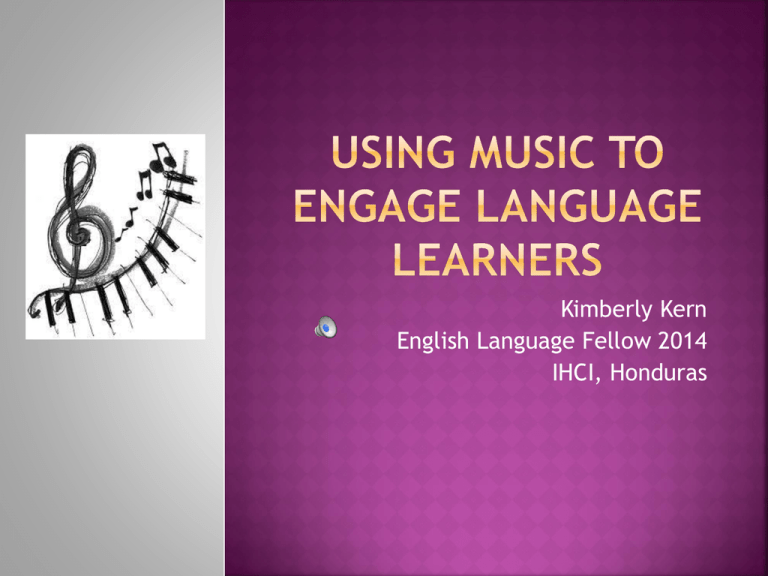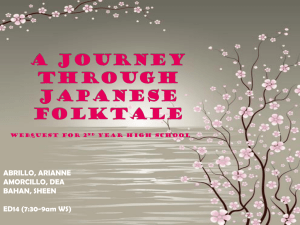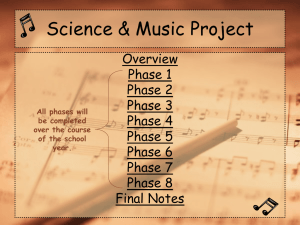USINg music to engage language learners - IHCI Resources
advertisement

Kimberly Kern English Language Fellow 2014 IHCI, Honduras Warm Up- TPR with Music You put your right foot in, you put your right foot out, you put your right foot in, and you shake it all about! You do the hokey pokey and you turn yourself around. That’s what it’s all about! (clap) Right foot, left foot, right arm, left arm, right elbow, left elbow, head, right hip, left hip, whole self, back side Improves concentration Improves memory Makes learning fun Helps students absorb material Motivates learning Brings a sense of community Relaxes people who are stressed Encourages multiple learning styles Receptive Active listening activities Active reading activities Expressive language skills: Language Skills Speaking/ pronunciation activities Writing activities Grammar Cultural/historical awareness American culture and expressions/ idioms World history and world cultures Listen once and write any words; listen again for more new words Close activity Match the phrases Specific details Listening for “gist” or main idea Arrange song lyrics in order as they listen to the song repeatedly. Listen to “Rainbow Connection” by Kermit the Frog. How many times does he say “rainbow”? Close activity: insert words that make sense in context Using "authentic” lyrics: search for main idea, theme, details. Research interpretations of songs and compare and contrast analysis Read about an artist or group Ex: The Beatles Read about the history or genre of music Ex: Jazz, Pop, Rock, Rap Read this paragraph about the historical and geographical context of “Penny Lane.” Paul McCartney was sitting at a bus shelter waiting for John Lennon to meet him on Penny Lane, a street near their houses. While sitting there Paul jotted down the things he saw, including a barber's shop with pictures of its clients and a nurse selling poppies for Remembrance Day (November 11th or the day World War 1 officially ended). He later turned these into the song we now know. Penny Lane still contains the bank and barber's shop mentioned in the song. Is there a good “people watching” place in your city? Read this interpretation of the song’s lyrics. Do you agree? "In Penny Lane there is a barber showing photographs of ev’ry head he’s had the pleasure to know. And all the people that come and go stop and say ‘Hello’." He keeps a set of photos of everyone famous he's met, like an autograph book. Not too out there, but still strange behavior. The ordinary people of Penny Lane/Liverpool want to be near greatness, so they participate in the oddity, and stop in to look at the photos of people they'll never be. Braintorm about the topic of the song Sing and/or act out a song. Groups explain the lyrics of a song Karaoke at the end of class! Work on specific pronunciation. Discuss the emotions of songs/genres Students create questions related to the song and discuss Summarize a song. Create their own lyrics using a grammar pattern Classroom theme song Student “songbooks”. Personal feelings/emotions Translate a favorite song Write interpretations to a songwhat is it REALLY about? If I were a bed, I’d get to snuggle all day I’d be sheets and soft pillows and I’d never be cold again. If I were a bed, I’d get to watch some TV, I’d always be comfortable and I’d never complain again. Teach a song that uses a new tense or pattern you have introduced to PRACTICE: Hokey Pokey- Imperative, Present, Possessive I Don’t Know Why, Norah Jones- Past The Rainbow Connection, Kermit- Questions Penny Lane, The Beatles- prepositions Rudolf the Red-nosed Reindeer- adjectives A Thousand Years, Christina Perri- mixed tenses If I Were a Boy, Beyonce- Conditional Music is represented uniquely in every culture around the world. Each region of the world has different influences and traditional purposes for music. Showing videos and playing recordings as examples of lifestyle in other countries will engage and excite students while simultaneously broadening their cultural horizon. Learning through music also allows for teaching of historical context as well as similarities and differences of music students listen to daily. Holiday vocabulary through traditional carols and songs Ex: 12 Days of Christmas Sociopolitical context or literary history Ex: Civil Rights Era/ Vietnam War (John Lennon) Ex: 1920 Prohibition (Charleston) Ex: Hip Hop culture (M.I.A) Famous people and world issues Ex: Nelson Mandela and apartheid in South Africa (The Specials) Ex: King Tut (Steve Martin) Slang expressions and idioms Ex: "I heard it through the Grape Vine" (Marvin Gaye) Geography Ex: School House Rock! (50 Nifty United States) "Musical nourishment which is rich in vitamins is essential for children." Zolton Kodaly isabelperez.com americanenglish.state.gov/resources/sing- out-loud-traditional-songs americanenglish.state.gov/resources/singout-loud-childrens-songs americanenglish.state.gov/resources/americ an-rhythms bussongs.com songsforteaching.com tefltunes.com eslcafe.com songfacts.com songmeanings.com lyricinterpretations.com/ songsforteaching.com/socialstudiessongs.htm Presidents, geography songsforteaching.com/index.html Math, science PattyShuklaKidsMusic.com Numbers, animals Text should fit the student’s level Stress a particular grammatical point or theme. Singer’s diction must be clear Variety of musical styles to reach the widest possible audience. Repetitious melody is helpful Repetitious chorus Introduce vocabulary before or after. Expose students to a song SEVERAL times! Choose interactive songs Add actions Begin or end a lesson with a song. Puppets for small children Personal songbooks/CDs Song and Poem Charts with pictures Watch youtube videos with lyrics Karaoke! Visit my website: kimberlykern.weebly.com Here you will find resources and a copy of this presentation for you to review and use!








